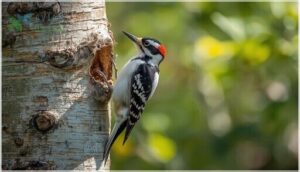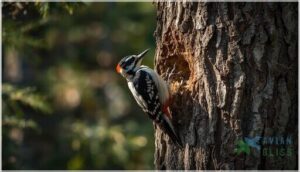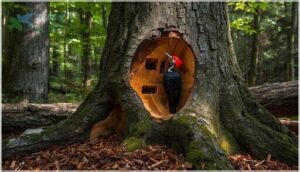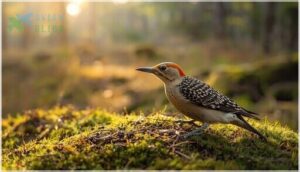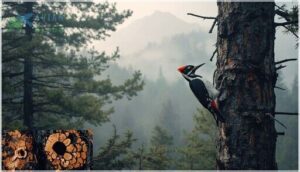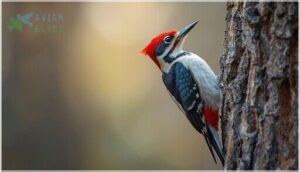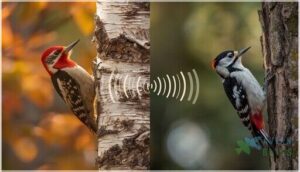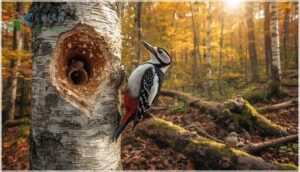This site is supported by our readers. We may earn a commission, at no cost to you, if you purchase through links.
A sharp tap-tap-tap against tree bark might be the first clue you’re sharing the woods with one of New Hampshire’s eight woodpecker species. These birds don’t just make noise—they drill rectangular holes you could mistake for construction work, chisel through ice-hardened bark in January, and create homes that shelter dozens of other wildlife species.
From the sparrow-sized Downy to the crow-sized Pileated with its flaming red crest, each species brings its own toolkit to the forest. Knowing which woodpecker you’re watching comes down to a few key details: bill shape, drumming rhythm, and hunting location. Once you know what to look for, you’ll spot the differences between a Hairy and a Downy in seconds.
Table Of Contents
- Key Takeaways
- Common Woodpecker Species in New Hampshire
- Identifying Woodpeckers by Sight and Sound
- Woodpecker Habitats and Distribution in New Hampshire
- Woodpecker Behavior and Ecological Roles
- Conservation and Attracting Woodpeckers Locally
- Frequently Asked Questions (FAQs)
- What is the most common woodpecker in New England?
- What is the big woodpecker in NH?
- Are woodpeckers protected in New Hampshire?
- How do you tell woodpeckers apart?
- How do woodpeckers avoid brain damage while pecking?
- What are common woodpecker predators in New Hampshire?
- How long do woodpeckers typically live?
- Can woodpeckers cause damage to house siding?
- What do woodpeckers eat besides insects?
- How long do woodpeckers live in the wild?
- Conclusion
Key Takeaways
- New Hampshire hosts eight woodpecker species ranging from the sparrow-sized Downy to the crow-sized Pileated, with identification hinging on bill length, drumming rhythm, and specific field marks like the Hairy’s chisel-like bill or the Pileated’s distinctive red crest.
- Woodpeckers function as ecosystem engineers by excavating cavities that shelter over 20 other species, controlling bark beetle populations by up to 75%, and dispersing seeds through caching behaviors that directly support forest regeneration.
- Climate change is driving measurable range shifts—Red-bellied Woodpeckers have quadrupled since 2000 while moving northward—and projections suggest over half of breeding ranges could contract by 2080, particularly threatening boreal specialists like the Black-backed Woodpecker.
- You can support local woodpecker populations by maintaining dead standing trees (snags), offering suet at backyard feeders, and participating in citizen science efforts like eBird, which has collected over 250,000 woodpecker observations from New Hampshire volunteers.
Common Woodpecker Species in New Hampshire
New Hampshire is home to eight woodpecker species, each with its own look and habits. You’ll find everything from the tiny Downy Woodpecker to the crow-sized Pileated Woodpecker drumming through the state’s forests and backyards.
Here’s what you need to know about each species you might spot.
Downy Woodpecker
You’ll spot the Downy Woodpecker often in your New Hampshire backyard—it’s the smallest native woodpecker here, just 5–7 inches long. Males show a red spot on the nape, while females lack it.
These birds nest in dead trees, excavating cavities 6–10 inches deep each spring. They eat bark beetle larvae and ants, giving you excellent natural insect control year-round.
They’re commonly found in open woodlands.
Hairy Woodpecker
The Hairy Woodpecker resembles a supersized Downy, measuring 9–10 inches with a longer, chisel-like bill. These year-round residents of New Hampshire’s mature forests drill into trunks for wood-boring beetle larvae. Males wear a red patch on the back of the head.
These woodpeckers are known to consume large numbers of insects, especially wood-boring beetles. Despite stable populations now, climate projections suggest Hairy Woodpeckers could lose over 75% of their breeding range by century’s end.
Pileated Woodpecker
You’ll know a Pileated Woodpecker by its crow-sized build and bold red crest. These woodpeckers in New Hampshire rebounded after reforestation, now thriving in mature forests with large snags. Their rectangular excavations expose carpenter ants—a dietary staple. Population trends remain stable, with over 1,000 winter sightings reported statewide.
- Requires trees at least 30 cm diameter for nesting cavities
- Carpenter ants make up 60% of their diet year-round
- Creates shelter for 20+ secondary cavity-nesting species
- Estimated 2.6 million individuals across North America
- Adapted to suburban woodlots alongside deep forest tracts
Red-bellied Woodpecker
The Red-bellied Woodpecker’s range expansion into New Hampshire since 2000 marks a significant shift. Their habitat preference leans away from dense conifers, favoring hardwood forests, river valleys, and even backyards.
Foraging habits blend insects (26% of diet) with mast and berries. Nesting ecology favors softer woods like maples.
Conservation status shows strongly increasing populations, with milder winters and reforestation fueling their northward march.
Northern Flicker
You’ll recognize Northern Flickers by their brown-barred backs, bold black chest crescent, and bright white rump in flight. Unlike other woodpeckers, they forage mostly on the ground, consuming more ants than any North American bird.
Populations have dropped to about 25% of historical levels due to habitat loss and competition with European Starlings, though they remain common breeders across New Hampshire’s open woodlands.
Black-backed Woodpecker
Black-backed Woodpeckers are extremely rare in New Hampshire, with no confirmed breeding since 2000. You’ll find them only in isolated spruce-fir forests of the White Mountains, where beetle infestations and fire ecology create their ideal habitat.
Their specialized diet of wood-boring beetle larvae makes them vulnerable to habitat loss and changing fire regimes, presenting significant conservation challenges in the state.
Yellow-bellied Sapsucker
The Yellow-Bellied Sapsucker stands out with its mottled back, striped face, and red throat (males) or white throat (females). This robin-sized woodpecker is commonly found along forest edges with birches, aspens, and maples throughout New Hampshire’s wooded areas.
They drill distinctive rows of sap wells in trees, tending them throughout the day. Their winter range has shifted northward in recent years.
Red-headed Woodpecker (rarity and Sightings)
Unlike other woodpeckers in this guide, the Red-Headed Woodpecker remains a vagrant species in New Hampshire. Most “sightings” turn out to be misidentification issues—usually Red-bellied Woodpeckers. With a historical absence in the state and ongoing population decline across its range, habitat suitability here is poor. Future prospects for breeding remain unlikely.
What makes this species so rare in New Hampshire:
- Fewer than five confirmed sightings per year since 2000
- No established breeding populations in the state
- Most reports are single birds, often misidentified
- Preferred open woodlands and oak savannas are scarce here
- Expert verification and photos needed for accurate woodpecker species identification during birdwatching in New Hampshire
Identifying Woodpeckers by Sight and Sound
Spotting a woodpecker in your backyard is one thing, but knowing which species you’re looking at takes a bit of practice. You’ll need to pay attention to a few key features that set each bird apart.
Let’s break down the main identification clues you can use to tell one woodpecker from another.
Size and Shape Differences
When you’re identifying different woodpecker species in New Hampshire, size matters. The Downy Woodpecker is your smallest at 5.5–6.7 inches, while the Pileated stretches to 16–19 inches—crow-sized and unmistakable.
Body mass and relative proportions help too. Notice bill morphology: the Downy’s is short and dainty, but the Hairy’s nearly matches its head length. Wing shape and tail structure add visual clues for woodpecker species identification.
Plumage and Coloration
When identifying woodpeckers by sight, plumage and coloration reveal critical details. Sexual dimorphism shows males sport red patches females lack. Age variation means juveniles display duller tones before molt changes bring vibrant adult colors.
Regional diversity appears in Northern Flickers’ yellow versus red underwings. Check outer tail feathers—Hairy Woodpeckers have pure white ones.
Plumage adaptation helps species blend into their forest homes perfectly.
Bill Length and Shape
Beyond color, you’ll notice that bill size separates similar-looking species. The Downy Woodpecker’s beak measures shorter than half its head width, while Hairy Woodpeckers sport bills nearly equal to head width—a clear field mark for woodpecker identification.
Bill variations reveal foraging specialization and biomechanical adaptations:
- Pileated Woodpeckers have chisel-shaped bills matching head length for drilling efficiency
- Northern Flickers show curved bills suited for ground foraging
- Yellow-bellied Sapsuckers possess shorter bills optimized for sap extraction
These structural differences drive dietary variation and impact resistance when identifying woodpeckers by sight in New Hampshire.
Distinctive Markings and Patterns
Once you’ve checked bill size, focus on distinctive field marks. White-backed species like Downy and Hairy Woodpeckers show clear plumage variations—males display a red patch on the head, absent in females.
Pileated Woodpeckers reveal their triangle red crest and white underwing patches in flight. Black-backed Woodpeckers stand out with solid black backs and males’ yellow crown.
Red-bellied Woodpeckers show zebra-striped barring across their backs, a key identifying characteristic in New Hampshire woodpecker identification.
Drumming Sounds and Calls
Once you’ve noted the plumage, listen carefully. Drumming functions as a territorial and mate attraction signal across New Hampshire woodpeckers.
Species patterns vary widely—Downy Woodpeckers drum at 9–16 rolls per minute, while Hairy Woodpeckers produce just 4–9. Pileated Woodpeckers deliver slower, resonant knocks lasting up to three seconds.
Call diversity helps too: Hairy Woodpeckers rattle evenly, but Downys descend in pitch.
Woodpecker Habitats and Distribution in New Hampshire
You’ll find woodpeckers throughout New Hampshire, from deep forests to your own backyard. Each species has carved out its own niche, preferring different types of trees and terrain.
Let’s look at where you’re most likely to spot these birds across the state.
Deciduous and Mixed Forests
Deciduous and mixed forests in New Hampshire are woodpecker hotspots, supporting about 87.5% of the state’s regular species. You’ll find these forests critical because:
- Habitat preferences: Downy Woodpeckers thrive in 92% of surveyed southern deciduous tracts
- Species distribution: Red-bellied Woodpeckers now occupy over 60% of suitable habitats
- Population trends: Woodpecker numbers increased 18% for Downies since the early 2000s
Coniferous and Burnt Forests
In coniferous forests, woodpeckers face tougher conditions—species richness drops as spruce and fir dominate. But after forest fires, everything changes. Black-backed Woodpeckers zero in on burnt areas where beetle abundance spikes, preferring sites with 42–52 snags per 100 acres.
High burn severity means more food and better nesting. Without careful forest management that protects these snags, New Hampshire’s fire specialists struggle to survive.
Suburban and Urban Areas
Even in New Hampshire’s suburban areas, you’ll spot Downy Woodpeckers and Northern Flickers—urban adaptation works when patch size matters. Larger woodland fragments with diverse habitat structure support more species, while small, isolated patches lose 30–50% of woodpecker richness.
Human impact is real, but conservation efforts like retaining mature trees turn backyards into strongholds for these backyard birds.
Importance of Dead Trees and Snags
Without snag ecosystems, cavity nesters like woodpeckers lose critical nesting sites—ten New Hampshire bird species depend on dead trees.
These standing giants support nutrient cycling and carbon sequestration while hosting beetles and larvae that fuel forest food webs. Trees over 18 inches diameter attract pileated woodpeckers, and retaining six snags per acre strengthens woodpecker habitats, forest regeneration, and overall ecosystem health in New Hampshire’s working landscapes.
Regional Distribution Patterns
Woodpecker species distribution across New Hampshire reveals striking patterns shaped by elevation, urbanization, and climate shifts. Downy Woodpeckers thrive statewide, while Red-bellied Woodpeckers have quadrupled since 2000, pushing northward through southern expansion along river valleys and urban habitats.
- Black-backed Woodpeckers remain rare, confined to northern limits above 3,000 feet in spruce-fir forests
- Habitat fragmentation barely affects Downy and Hairy species in small woodlots
- Elevational trends show Yellow-bellied Sapsuckers favoring mid-elevation mixed woods between 1,000–2,500 feet
Understanding these woodpecker range maps helps you predict which species you’ll encounter in New Hampshire wildlife habitats.
Woodpecker Behavior and Ecological Roles
Woodpeckers aren’t just drilling holes for fun—they’re busy engineers, pest controllers, and ecosystem architects all rolled into one. Their daily routines and behaviors ripple through New Hampshire’s forests in ways you mightn’t expect.
Let’s look at how these birds make their living and shape the woods around them.
Foraging Techniques and Diet
You’ll find that woodpeckers in New Hampshire show considerable prey specialization in their foraging behavior. Downy and Hairy woodpeckers drill into bark for beetle larvae, while Pileated woodpeckers excavate large holes targeting carpenter ants. Northern Flickers forage on the ground, consuming up to 5,000 ants per session.
Seasonal diets shift too—winter brings increased sap consumption and stored acorns. Their microhabitat use and ecological impact extend to controlling insect populations, with mortality rates reaching 40% in infested trees.
Cavity Excavation and Nesting
You’ll notice that woodpeckers in New Hampshire start cavity excavation in late April, taking 1 to 3 weeks to complete nesting sites. Dead trees serve as the preferred substrate in over 85% of observed locations.
Cavity dimensions vary—Downy Woodpeckers create holes 6–10 inches deep, while Northern Flickers excavate cavities reaching 14 inches.
Most species lay 4–6 eggs per clutch, and abandoned cavities support over 15 other bird species locally.
Seasonal Behaviors and Migration
After nesting wraps up, you’ll see migration patterns and seasonal behaviors shift across New Hampshire woodpeckers. Yellow-bellied Sapsuckers head south by September, while Northern Flickers migrate short distances in late autumn. Most species stay year-round, though winter adaptations kick in—Downy Woodpeckers join mixed flocks and roost in cavities for warmth, while foraging changes include increased reliance on cached nuts and sap.
- Yellow-bellied Sapsuckers migrate to southern U.S., Mexico, and Central America starting September
- Northern Flickers show short-distance migration, returning between late March and early April
- Downy Woodpeckers join mixed-species flocks in winter to improve food finding and predator avoidance
- Red-headed Woodpeckers cache acorns in fall for winter food reserves
- Climate impact influences range expansion, with Red-bellied Woodpeckers now more common year-round
Role in Insect Control and Seed Dispersal
Beyond those seasonal shifts, woodpeckers act as ecosystem engineers through insect control and seed dispersal. Their diet includes beetle larvae—hairy woodpeckers remove over 75% of bark beetle populations during outbreaks—while northern flickers consume more ants than any other New Hampshire bird. This insect population control protects forests from invasive species damage.
| Woodpecker Species | Primary Insect Prey | Forest Regeneration Role |
|---|---|---|
| Hairy Woodpecker | Bark beetle larvae (75%+ of diet) | Suppresses outbreaks in conifer stands |
| Northern Flicker | Ants (45% by volume) | Controls ant populations in edge habitats |
| Black-backed Woodpecker | Wood-boring beetle larvae | Targets post-fire beetle surges |
| Red-headed Woodpecker | Mixed insects, acorns cached | Seed caching aids oak recruitment |
Seed caching by red-headed woodpeckers moves acorns from dozens of parent trees into new sites, mixing oak genetics and boosting forest regeneration across New Hampshire landscapes.
Support for Other Wildlife
Woodpeckers support over 20 cavity-nesting species in New Hampshire—chickadees, nuthatches, and bluebirds depend on abandoned holes for nesting. These tree cavities boost forest regeneration and strengthen the food web:
- Flying squirrels and bats shelter in old excavations
- Wrens access woodpecker-exposed insects through foraging holes
- Amphibian refuges form in damp ground-level cavities
- Mammal communities thrive where snag density increases
Their ecosystem role extends beyond insect control.
Conservation and Attracting Woodpeckers Locally
You can do a lot to help woodpeckers thrive in New Hampshire, whether you’re managing forest land or just setting up a backyard feeder. Some species are doing well, while others face real challenges from habitat loss and changing conditions.
Here’s what you need to know about keeping these birds around and how you can make a difference in your own yard.
Population Trends and Threats
Some species are on the rise—Red-bellied Woodpecker populations surged since the early 2000s thanks to range expansion driven by climate change and backyard feeders.
But threats to woodpecker populations remain. Habitat loss from development, invasive species like emerald ash borer, and forest management practices that remove dead wood all impact woodpeckers in New Hampshire. Climate impacts continue reshaping where they nest and what they eat.
Habitat Preservation Strategies
When forests are managed with care, woodpeckers thrive. Snag retention—keeping dead trees standing—gives cavity-nesters the homes they need. Selective logging maintains mature stands, while fire management restores natural structure.
Connectivity corridors link fragmented woods, letting populations spread. Sustainable forestry practices balance timber needs with habitat protection.
Community engagement through monitoring helps track what’s working, guiding conservation strategies that slow habitat loss across New Hampshire.
Backyard Feeding and Bird-Friendly Practices
At your feeder, suet is king—northern New England surveys show a 63% boost in Downy and Hairy visits when homeowners add suet feeder types alongside seed. Tail-prop designs help larger species grip.
Place nest boxes 8–20 feet high, spaced 50 yards apart. Clean feeders every two weeks to prevent disease.
Attracting woodpeckers to your yard means offering peanuts, black oil sunflower, and maintaining good feeder hygiene for healthy backyard birding in New Hampshire.
Citizen Science and Monitoring Efforts
When you submit woodpecker sightings through eBird or Project FeederWatch, you’re joining roughly 4,000 New Hampshire volunteers whose data quality drives real conservation impact.
Over 250,000 woodpecker observations now inform research efforts statewide. Participation rates jumped 23% since 2019, with technological tools like mobile apps making community involvement easier.
Your backyard monitoring helps track population trends and protect important habitats.
Impact of Climate Change on Populations
Climate change is reshaping woodpecker populations across New Hampshire in measurable ways. Range shifts are evident as species like Red-bellied Woodpeckers expand northward with warming temperatures.
Habitat loss threatens boreal specialists as spruce-fir forests shrink. Food scarcity, resulting from mistimed insect peaks, reduces breeding success, while altered migration patterns affect survival rates.
By 2080, over half of woodpecker breeding ranges may contract statewide.
Climate change could shrink more than half of New Hampshire’s woodpecker breeding ranges by 2080
Frequently Asked Questions (FAQs)
What is the most common woodpecker in New England?
You’ll spot the Downy Woodpecker most often across New England. Regional surveys confirm this tiny black-and-white bird dominates backyard feeders and woodlands throughout Northeast woodpecker species, thriving in New Hampshire’s varied habitats year-round.
What is the big woodpecker in NH?
The Pileated Woodpecker is New Hampshire’s largest woodpecker, measuring 16–19 inches long. You’ll recognize it by its striking red crest, black body, and white neck stripes in mature forests statewide.
Are woodpeckers protected in New Hampshire?
Yes, woodpeckers are protected under federal law in New Hampshire. You can’t harm or remove them without permits requiring proof you’ve tried non-lethal methods first. Legal consequences include significant fines for violations.
How do you tell woodpeckers apart?
You can tell woodpeckers apart by checking size differences, plumage variations, bill morphology, and drumming patterns.
Habitat clues and distinctive markings—like crown color or wing stripes—also help with accurate identification.
How do woodpeckers avoid brain damage while pecking?
Woodpeckers withstand impacts of 1,200–1,400 g through several cranial adaptations. These include a spongy shock-absorbing skull bone, a compact brain size that minimizes movement, and a hyoid bone wrapping around the skull. This unique structure efficiently dissipates impact energy.
What are common woodpecker predators in New Hampshire?
Like many cavity nesters, woodpeckers face nest predation from Cooper’s hawks, American martens, and rat snakes. Mammalian threats include raccoons and squirrels, while human impacts—particularly habitat modification and domestic cats—increasingly affect New Hampshire woodpecker populations.
How long do woodpeckers typically live?
Most species you’ll encounter in New Hampshire live between 9 and 15 years in the wild, though survival rates depend heavily on habitat quality, predation pressures, and available nesting sites.
Can woodpeckers cause damage to house siding?
Yes, they can peck holes in wood, plywood, and even synthetic siding. Grooved plywood faces the highest risk at 73%, while fiber cement and metal options resist damage better.
What do woodpeckers eat besides insects?
You’ll find these birds snacking on fruits like grapes and apples, along with nuts such as acorns and peanuts.
They’ll also tap into tree sap, especially during spring when insects are scarce.
How long do woodpeckers live in the wild?
Woodpeckers navigate a gauntlet of challenges that shape their wild lifespan. In New Hampshire, most species live 4 to 12 years, though predator impact, resource scarcity, habitat loss, and disease effects often cut lives short—banding data reveals the truth.
Conclusion
A Pileated Woodpecker can excavate a nest cavity in three weeks—proof that patience and the right tools get results. You’ve now got both.
The next time you hear drumming echo through New Hampshire’s woods, you won’t just wonder what’s out there. You’ll know whether it’s a Downy working the understory or a Hairy hammering higher up. That tap-tap-tap just became your invitation to notice what’s been there all along.


